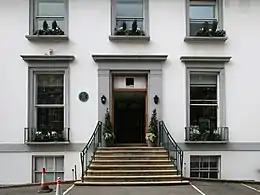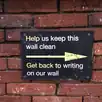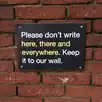 | |
 Abbey Road Studios in December 2005 | |
| Formerly | EMI Recording Studios |
|---|---|
| Type | Recording studio |
| Industry | Music |
| Founded | November 12, 1931[1] |
| Founder | Gramophone Company |
| Headquarters | St John's Wood, City of Westminster, London, England |
| Parent | Universal Music Group |
| Website | abbeyroad |
| Abbey Road Studios | |
|---|---|
 | |
| Built | 1829[2] |
| Architectural style(s) | Georgian |
Listed Building – Grade II | |
| Official name | Abbey Road Studios |
| Designated | 23 February 2010 |
| Reference no. | 1393688[3] |
Listed Building – Grade II | |
| Official name | Zebra crossing near Abbey Road Studios |
| Designated | 21 December 2010 |
| Reference no. | 1396390[4] |
Abbey Road Studios (formerly EMI Recording Studios) is a music recording studio at 3 Abbey Road, St John's Wood, City of Westminster, Greater London, England.[5] It was established in November 1931 by the Gramophone Company, a predecessor of British music company EMI, which owned it until Universal Music Group (UMG) took control of part of it in 2013. It is ultimately owned by UMG subsidiary Virgin Records Limited (until 2013 by EMI Records Limited, nowadays known as Parlophone Records and owned by UMG's competitor Warner Music Group).
The studio's most notable client was the Beatles, who used the studio – particularly its Studio Two room – as the venue for many of the innovative recording techniques that they adopted throughout the 1960s. In 1976, the studio was renamed from EMI to Abbey Road.
In 2009, Abbey Road came under threat of sale to property developers. In response, the British Government protected the site, granting it English Heritage Grade II listed status in 2010, thereby preserving the building from any major alterations.[6]
History
1920s–1940s
Originally a nine-bedroom Georgian townhouse built in 1831 on the footpath leading to Kilburn Abbey, the building was later converted to flats where the best-known resident was Maundy Gregory, who was famous (or infamous) for selling political honours.
In 1929, the Gramophone Company acquired the premises. The property benefited from a large garden behind the townhouse, which permitted a much larger building to be constructed to the rear; thus, the Georgian façade belies the true dimension of the building. Three purpose-built studios were constructed and the existing house was adapted for use as administration offices. Pathé filmed the opening of the studios in November 1931 when Edward Elgar conducted the London Symphony Orchestra in recording sessions of his music.[7][8] In 1934, the inventor of stereo sound, Alan Blumlein, recorded Mozart's Jupiter Symphony which was conducted by Thomas Beecham at the studios.[9]
The neighbouring house is also owned by the studio and used to accommodate musicians. During the mid-20th century, the studio was extensively used by British conductor Sir Malcolm Sargent, whose house was located near the studio building.[10]
The Gramophone Company merged with Columbia Graphophone Company to form Electric and Musical Industries (EMI) in 1931, and the studios later became known as EMI Recording Studios.[11] In 1936 cellist Pablo Casals became the first to record Johann Sebastian Bach's Cello Suites No. 1 & 2 at the command of EMI head Fred Gaisberg. The recordings went on to spur a revolution among Bach aficionados and cellists alike.[12] "Fats" Waller played the Compton organ there.
Glenn Miller recorded at the Abbey Road studios during the war, when he was based in the United Kingdom.[13]
In 1931 an echo chamber was built in the studios, in the early days of artificial reverberation.[14]
1950s–1970s

In 1958, Studio Two at EMI became a centre for rock and roll music when Cliff Richard and the Drifters (later Cliff Richard and the Shadows) recorded "Move It" there,[15] and later pop music material.
EMI is closely associated with the Beatles, who recorded almost all of their albums and hits there between 1962 and 1970 using the four-track REDD mixing console designed by Peter K. Burkowitz.[16] The Beatles named their 1969 album Abbey Road.[17][18][19] Iain Macmillan took the album's cover photograph outside the studios, with the result that the nearby zebra crossing has become a place of pilgrimage for Beatles fans. It has been a tradition for visitors to pay homage to the band by writing on the wall in front of the building even though it is painted over every three months.[20] In December 2010, the zebra crossing at Abbey Road was given a Grade II listed status.[21]
After becoming the studio's general manager in 1974, Ken Townsend began a rebranding effort to capitalise on the studio's connection with the Beatles. To emphasise the studio's independence, Townsend commissioned the artist Alan Brown to design a unique logo, and in 1976 the facility officially changed names from EMI Studios to Abbey Road Studios.[22][23][lower-alpha 1] Having previously been mostly restricted to UK-based EMI acts, the studio's name-change served the added purpose of encouraging non-EMI acts to record at the studio.[22][23]
Notable producers and sound engineers who have worked at Abbey Road include Fred Gaisberg (who had first recorded Enrico Caruso in Milan in 1902, and had set up the first recording studio in London at Maiden Lane in 1898), Walter Legge, George Martin, Tutti Camarata, Geoff Emerick, Norman "Hurricane" Smith, Ken Scott, Mike Stone, Alan Parsons, Peter Vince, Malcolm Addey, Peter Bown, Richard Langham, Phil McDonald, John Kurlander, Richard Lush and Ken Townsend, who invented the studio effect known as automatic double tracking (ADT). The chief mastering engineer at Abbey Road was Chris "Vinyl" Blair, who started his career as a tape deck operator.
From 1966 to 1971, the Walt Disney Music Company recorded vocals, instrumentals and narration and dialogue for over a dozen albums at Abbey Road for U.S. and international release, including The Aristocats, Bedknobs and Broomsticks, Doctor Dolittle, Heidi and The Wizard of Oz. Most of the sessions including The Mike Sammes Singers, who backed up The Beatles on "I Am the Walrus" and "Good Night."[24]
In 1979, EMI commissioned the British jazz fusion band Morrissey-Mullen to record Britain's first digitally recorded single record at Abbey Road Studios.[25][26]
1980s–2010s
Abbey Road Studios got its start in the film scoring business in 1980 when Anvil Post Production formed a partnership with the studio, called Anvil-Abbey Road Screen Sound. The partnership started when Anvil was left without a scoring stage when Denham Studios were demolished. It ended in 1984 when EMI merged with Thorn Electrical Industries to become Thorn EMI. Abbey Road's success in the scoring business continued after the partnership ended.
From 18 July to 11 September 1983, the public had a rare opportunity to see inside the Studio Two room, where the Beatles made most of their records. While a new mixing console was being installed in the control room, the studio was used to host a video presentation called The Beatles at Abbey Road. The soundtrack to the video had a number of recordings that were not made commercially available until the release of The Beatles Anthology project over a decade later.[27]
In September 2012, with the takeover of EMI, the studio became the property of Universal Music. It was not one of the entities that were sold to Warner Music as part of Parlophone and instead the control of Abbey Road Studios Ltd was transferred to Virgin Records.
Controversy over sale
On 17 February 2010, it was reported that EMI had put the studios up for sale because of increasing debts. There was reported interest by property developers in redeveloping the site into luxury flats.[28] It had also been reported there was a possibility the studios could be purchased by the National Trust[29] to preserve what was in effect a historical building. A Save Abbey Road Studios campaign attempted to ensure the premises remained a working studio.[30]
On 21 February 2010, EMI stated it planned to keep the studio and was looking for an investor to help finance a "revitalization" project.[31][32] Meanwhile, the British government declared Abbey Road Studios a Grade II listed building which protected it from major alteration.[32][33] The following December, the pedestrian crossing at Abbey Road was listed on the National Heritage List.[34]
Paul McCartney, speaking to BBC Newsnight on 16 February 2010, said there had been efforts to save Abbey Road by "a few people who have been associated with the studio for a long time," although he did not name them or include himself among them. "I have so many memories there with the Beatles," McCartney said, "It still is a great studio. So it would be lovely for someone to get a thing together to save it."[35]
Abbey Road Institute
In March 2015, Abbey Road Institute was founded as a school for music production and audio engineering.[36] In addition to the London location, Abbey Road Institute offers education globally with schools in Amsterdam, Frankfurt, Johannesburg, Miami, Paris and Sydney.[37] All of the campuses offer the same course, the Advanced Diploma in Music Production and Sound Engineering, which has been developed in collaboration with industry leaders and the team at Abbey Road Studios. Some campuses offer additional short courses, including Portfolio Preparation, Song Production Masterclass, Music theory Fundamentals for Producers amongst others. In April 2021, Abbey Road Institute London announced it would be expanding and moving into the currently closed Angel Recording Studios in the summer of 2021.
Notes
- ↑ A 2012 article in Sound on Sound magazine instead dates the name change to 1970.[17]
References
- ↑ "Our Story". Abbey Road. Retrieved 6 July 2022.
- ↑ "About us – Abbey Road Studios". Abbey Road. Retrieved 6 July 2022.
- ↑ Historic England. "Abbey Road Studios (1393688)". National Heritage List for England. Retrieved 18 May 2018.
- ↑ Historic England. "Zebra crossing near Abbey Road Studios (1396390)". National Heritage List for England. Retrieved 5 October 2021.
- ↑ "Studio 1". Abbey Road Studios; EMI Records Limited. Archived from the original on 14 July 2011. Retrieved 19 August 2011.
- ↑ "Abbey Road studios given listed building status". BBC News. 23 February 2010. Archived from the original on 14 June 2022. Retrieved 19 August 2011.
- ↑ "Recording the Star Wars Saga" Archived 9 April 2011 at the Wayback Machine Retrieved 4 August 2012.
- ↑ "Sir Edward Elgar, Master of the King's Music. "Land of hope & glory"". 1931. Archived from the original on 8 August 2017. Retrieved 27 November 2016 – via YouTube.
- ↑ Shankleman, Martin (1 August 2008). "Early stereo recordings restored". BBC. Retrieved 16 December 2023.
- ↑ Discography in Sir Malcolm Sargent: a Tribute.
- ↑ Hewitt, Paolo (24 May 2000). "One for the road". The Guardian. Archived from the original on 8 March 2021. Retrieved 25 April 2018.
- ↑ Siblin, Eric (4 January 2011). The Cello Suites: J. S. Bach, Pablo Casals, and the Search for a Baroque Masterpiece. Crows Nest, New South Wales: Allen & Unwin. p. unstated. ISBN 978-1-74237-159-7. Archived from the original on 24 July 2020. Retrieved 17 October 2016 – via Google Books.
- ↑ Visit Abbey Road. "1940s" Archived 19 November 2008 at the Wayback Machine, Abbeyroad.com (16 September 1944). Retrieved 29 July 2011.
- ↑ Curtis Roads (2015) | Composing Electronic Music - A New Aesthetic| Oxford University Press
- ↑ "EMI puts Abbey Road up for sale: Ten things you need to know about the iconic recording studio". The Mirror. London. 16 February 2010. Archived from the original on 28 July 2014.
- ↑ Peter Karl Burkowitz 1920–2012 Archived 13 December 2014 at the Wayback Machine Obituary by the AES
- 1 2 Bieger, Hannes (November 2012). "Abbey Road Studios, London". Sound on Sound. Retrieved 16 December 2023.
- ↑ Lancy, Justin (23 October 2014). "The Technical Constraints That Made Abbey Road So Good". The Atlantic. Archived from the original on 23 October 2014. Retrieved 14 February 2019.
- ↑ Atkinson, Peter (2015). "Abbey Road Studios, the Tourist, and Beatles Heritage". Relocating Popular Music. pp. 129–147. doi:10.1057/9781137463388_7. ISBN 978-1-349-69057-2.
- ↑ Pollard, Lawrence (7 August 2009). "Revisiting Abbey Road 40 Years On". BBC. Archived from the original on 18 December 2020. Retrieved 2 November 2010.
- ↑ Taylor, Matthew (2 January 2011). "Housing minister tries to save Ringo Starr's childhood home". The Guardian. London. Archived from the original on 8 March 2021. Retrieved 19 August 2011.
- 1 2 Womack 2019, pp. 237–238.
- 1 2 Womack, Kenneth (25 September 2019). "The Legacy of Abbey Road: Rebranding EMI Studios for the Ages with Ken Townsend". Cornell University Press. Archived from the original on 15 February 2022. Retrieved 30 May 2022.
- ↑ Hollis, Tim (2006). Mouse tracks : the story of Walt Disney Records. Greg Ehrbar (First ed.). Jackson: University Press of Mississippi. ISBN 1-57806-848-7. OCLC 61309354.
- ↑ Gramophone AUDIO NEWS: "EMI digital recording" July 1979. Retrieved 19 August 2010. "EMI digital recording". Archived from the original on 1 August 2012. Retrieved 25 August 2016.
- ↑ Robertshaw, Nick (26 May 1979). "EMI Enters Digital Race with System". Billboard. pp. 3, 71.
- ↑ The Beatles Book July & August 1983.
- ↑ Smyth, Chris; Power, Helen (17 February 2010). "End for Abbey Road? EMI puts Beatles' studios up for sale at £30m". The Times. London. Archived from the original on 14 June 2022. Retrieved 19 February 2010.
- ↑ TJ. "Should the National Trust save Abbey Road Studios". Nationaltrust.org.uk. Archived from the original on 17 August 2010. Retrieved 19 September 2010.
- ↑ "Stop the legendary studios becoming luxury flats". Save Abbey Road Studios!. February 2010. Archived from the original on 24 February 2010.
- ↑ "Abbey Road studios 'not for sale,' says EMI". BBC News. 21 February 2010. Archived from the original on 22 February 2010. Retrieved 20 February 2010.
- 1 2 "Abbey Road studios to be listed by British authorities". The Independent. 27 February 2010. Archived from the original on 26 July 2014.
- ↑ "Abbey Road Studios Grade II Listed". The National Heritage List for England. 23 February 2010. 1393688. Archived from the original on 27 July 2014.
- ↑ "Beatles 'Abbey Road' crossing given heritage status". The Independent. 23 December 2010. Archived from the original on 26 July 2014.
- ↑ Sisario, Ben (18 February 2010). "McCartney Expresses Hopes for Abbey Road". The New York Times. Archived from the original on 8 March 2021. Retrieved 27 March 2010.
- ↑ "Abbey Road Studios opens school of music production and sound engineering". factmag.com. 19 March 2015. Archived from the original on 8 November 2020. Retrieved 25 January 2017.
- ↑ Siddique, Haroon (19 March 2015). "Music institute opens in Beatles' Abbey Road Studios". The Guardian. Archived from the original on 8 March 2021. Retrieved 2 September 2016.
Sources
- Womack, Kenneth (2019). Solid State: The Story of Abbey Road and the End of the Beatles. Ithaca, New York: Cornell University Press. ISBN 978-1-5017-4685-7. Archived from the original on 22 August 2021.
Further reading
- Lawrence, Alistair (2012). Abbey Road: The Best Studio in the World. New York: Bloomsbury. ISBN 978-1-60819-999-0.



